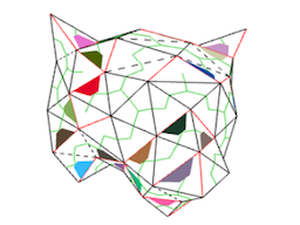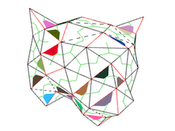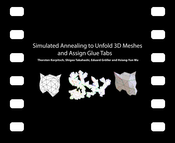Information
- Publication Type: Conference Paper
- Workgroup(s)/Project(s):
- Date: May 2020
- Lecturer: Hsiang-Yun Wu
- Event: WSCG 2020
- Call for Papers: Call for Paper
- Booktitle: Proceedings of the 28th International Conference in Central Europe on Computer Graphics
- Conference date: 19. May 2020 – 21. May 2020
- Pages: 1 – 10
Abstract
3D mesh unfolding transforms a 3D mesh model into one or multiple 2D planar patches. The technique is widely used to fabricate papercrafts, where 3D objects can be reconstructed from printed paper or paper-like materials. The applicability, visual quality, and stability of such papercraft productions is still challenging since it requires a reasonable formulation of these factors. In this paper, we unfold a 3D mesh into a single connected 2D patch. We also introduce glue tabs as additional indicators in order to provide users with extra space to apply glue for better reconstruction quality. To improve space efficiency, we do not apply glue tabs on every edge, while still guaranteeing the stability of the constructed paper model. A minimum spanning tree (MST) describes possible unfoldings, whereas simulated annealing optimisation is used to find an optimal unfolding. Our approach allows us to unfold 3D triangular meshes into single 2D patches without shape distortions, and employing only a small number of glue tabs. A visual indicator scheme is also incorporated as a post-process to guide users during the model reconstruction process. Finally, we qualitatively evaluate the applicability of the presented approach in comparison to the conventional technique and the achieved results.Additional Files and Images
Weblinks
BibTeX
@inproceedings{Korpitsch-2020-wscg,
title = "Simulated Annealing to Unfold 3D Meshes and Assign Glue Tabs",
author = "Thorsten Korpitsch and Shigeo Takahashi and Eduard
Gr\"{o}ller and Hsiang-Yun Wu",
year = "2020",
abstract = "3D mesh unfolding transforms a 3D mesh model into one or
multiple 2D planar patches. The technique is widely used to
fabricate papercrafts, where 3D objects can be reconstructed
from printed paper or paper-like materials. The
applicability, visual quality, and stability of such
papercraft productions is still challenging since it
requires a reasonable formulation of these factors. In this
paper, we unfold a 3D mesh into a single connected 2D patch.
We also introduce glue tabs as additional indicators in
order to provide users with extra space to apply glue for
better reconstruction quality. To improve space efficiency,
we do not apply glue tabs on every edge, while still
guaranteeing the stability of the constructed paper model. A
minimum spanning tree (MST) describes possible unfoldings,
whereas simulated annealing optimisation is used to find an
optimal unfolding. Our approach allows us to unfold 3D
triangular meshes into single 2D patches without shape
distortions, and employing only a small number of glue tabs.
A visual indicator scheme is also incorporated as a
post-process to guide users during the model reconstruction
process. Finally, we qualitatively evaluate the
applicability of the presented approach in comparison to the
conventional technique and the achieved results.",
month = may,
event = "WSCG 2020",
booktitle = "Proceedings of the 28th International Conference in Central
Europe on Computer Graphics",
pages = "1--10",
URL = "https://www.cg.tuwien.ac.at/research/publications/2020/Korpitsch-2020-wscg/",
}


 image
image paper
paper video
video

